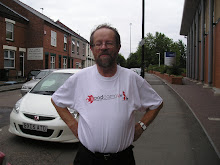 For the first time since we’ve been in Europe, Celia went in one direction this morning and I went in another. We arranged to be home by three o’clock. I had the cellphone, and Celia had the number (and the street address). It felt quite strange, as we’ve hardly been apart for more than half an hour since we arrived in Hamburg at the beginning of the month.
For the first time since we’ve been in Europe, Celia went in one direction this morning and I went in another. We arranged to be home by three o’clock. I had the cellphone, and Celia had the number (and the street address). It felt quite strange, as we’ve hardly been apart for more than half an hour since we arrived in Hamburg at the beginning of the month.Anyway, Celia went off to the mall/supermarket (I hardly need to remind you that these are her museums), and I went to the Museum of Fine Arts, which is in easy walking distance. And it was free.
What a dream of a place! In the large foyer, there are paintings that would barely fit on the walls of our apartment. As you go in beyond this there are rooms and rooms of wondrous religious art, some of it huge. Upstairs is a mixture of later art works, with more portraits, and then upstairs again are more modern works, though nothing seems to date much beyond the beginning of the twentieth century.
It was exhausting just trying to take it all in, what with Goya and El Greco and various other great Spanish painters on display. And then there were two courtyards: one is a wonderful fresh garden, with palm trees, and green, green plants. The other is bare apart from a statue of Martin de Tours and the beggar. However, around the windows on the first floor is a wondrous blue colour.
It’s interesting how limited the range of subject matter is in religious art. While the Spanish paint St Francis a good deal more than other countries, there are dozens of versions of the Crucifixion and the events surrounding it. Curiously there aren’t many Nativity scenes in this museum. But there is one vital and energetic picture of the Holy Family (plus John the Baptist). Unusually the two boys are grown men in this picture and along with Joseph they’re hammering away at something not very obvious in the centre in a very muscular fashion. Mary is stuck on one side.
St Sebastian comes in for several portraits. [That's him in the picture.] Here in Spain he’s always shown in his dying agony with just one arrow in him. (Usually in other countries there’s a welter of arrows). It’s a puzzle why he’s such a choice subject for artists. I’ve just had a look at the interesting Wikipedia article on him, and seemingly even though he was shot full of arrows he survived, was nursed back to health, and went on to bring more people to Christ. So it’s interesting that the Spanish versions have him with only one arrow, and obviously dead. The other curious thing is that he’s always virtually naked in whatever country he’s painted, and his body is always romanticised as being a fine specimen of young manhood. (The Spanish tend to make him a youth, in fact, which he wasn’t when he was shot.)
In the museum there are few examples of mythical art, though the Rape of the Sabines makes its usual appearance. It’s curious that this is another motif that’s so common in art of this time. Is it because we lean towards certain themes, or is it because of something altogether different? It’d be interesting to know.
After this I made my way into town (which is when I discovered that the Metro is both underground and tram) and finally found a place to post the postcards we’ve been carrying around for days. At the Post Office, of course. Post boxes are a rare thing in Valencia, as far as we can make out.
Celia finally arrived home half an hour after our arranged time, absolutely exhausted, of course, but still fairly cheerful. Her foot had stood up to the pace, apparently.







